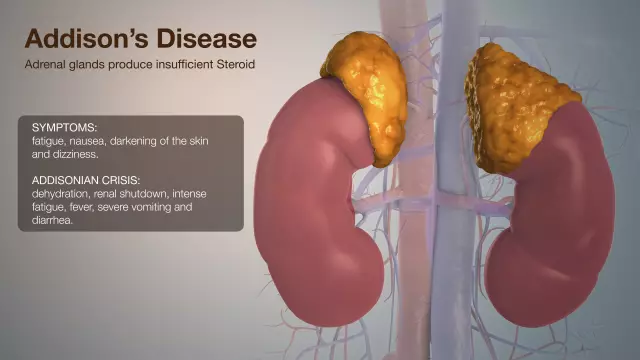- Author Rachel Wainwright [email protected].
- Public 2023-12-15 07:39.
- Last modified 2025-11-02 20:14.
Pick's disease
The content of the article:
- Causes and risk factors
- Disease stages
- Symptoms
- Diagnostics
- Treatment
- Possible complications and consequences
- Forecast
- Prevention
Pick's disease is a variant of senile dementia (senile acquired dementia), the development of which is associated with atrophy of the cerebral cortex in the region of the frontal and temporal lobes.

In the initial stages of Pick's disease, patients may be in a state of euphoria and apathy.
The disease got its name in honor of the psychiatrist Arnold Pick, who first described it in 1892. At the same time, he himself believed that this pathology is not a separate nosological unit, but is one of the clinical variants of the course of senile dementia. However, further research made it possible to isolate Pick's disease as an independent disease.
No data have been collected on the incidence of Pick's disease, as there are significant difficulties in performing intravital diagnostics. It is known that the disease occurs in people between the ages of 50 and 60. Women get sick more often than men.
Causes and risk factors
The exact causes underlying the development of Pick's disease are still unknown.
Due to the fact that family cases of the disease have been observed, a number of researchers suggest its hereditary nature. However, familial cases are observed much less frequently than sporadic cases, in addition, within the same family, Pick's disease usually affects not relatives from different generations, but siblings. Therefore, it seems more reasonable to assume that the development of the disease can lead to exposure to the brain of various toxic substances.

The death of neurons in the brain in Pick's disease
The provoking factors can be:
- hypovitaminosis conditions;
- mental disorders;
- traumatic brain injury;
- various types of intoxication;
- repeated general anesthesia with the use of unreasonably high doses of psychotropic drugs.
With Pick's disease, an atrophic process occurs in the frontal and temporal lobes of the brain, affecting the cortex and subcortical structures. It is most pronounced in the dominant hemisphere. There are no vascular disorders and inflammatory changes in the altered brain structures.
Disease stages
In the clinical picture of Pick's disease, three successive stages are distinguished:
- Initial. It is characterized by a change in the patient's personality with the loss of moral principles.
- The stage of cognitive impairment. Mental activity worsens, memory decreases.
- Deep dementia. Patients need constant care, as they lose the ability to basic self-care.

MRI of the brain of a woman with Pick's disease
Symptoms
In the initial stages of Pick's disease, patients exhibit antisocial behavior and pronounced selfishness. They lose the ability to control their actions, as a result of which they become eccentric - in particular, they satisfy basic instincts, including sexual desire, regardless of the people and environment. Criticism towards their actions is reduced. Against this background, various disorders are formed, for example, bulimia or hypersexuality.
In the initial stages of Peak's disease, patients may be in a state of euphoria and apathy. They develop a characteristic speech disorder, which manifests itself in the constant repetition of the same anecdotes, phrases, individual words - "a symptom of a gramophone record." As the disease progresses, sensorimotor aphasia develops - the ability to verbally express thoughts, as well as understanding the speech of others, is lost. Then other cognitive functions are lost: counting (acalculia), writing (agraphia) and reading (alexia).

In the late stages of Pick's disease, patients become unable to self-care.
In the future, patients lose the ability to consistently perform actions (violations of praxis), their perception of the world around them changes (agnosia), memory loss (amnesia) occurs. The outcome is profound dementia. Patients cannot take care of themselves, are disoriented in time and space, immobilized.
Diagnostics
Intravital diagnosis of Pick's disease is difficult. The data of an objective examination of the patient, the collection of anamnesis, and a survey of the patient's relatives are of diagnostic value.
Magnetic resonance imaging is shown. It allows you to assess the state of the cerebral cortex and identify the characteristic atrophy in the temporal and frontal lobes.

MRI detects changes in the frontotemporal lobe characteristic of Peak's disease
Differential diagnosis is required with schizophrenia, arteriovenous malformation of the brain, tumors of the frontal lobe of the brain, Alzheimer's disease and vascular dementia.
Treatment
Specific therapy for Pick's disease has not been developed. The main goal of treatment is to slow down the progression of the disease, for which nootropic and anticholinesterase drugs are prescribed. With pronounced aggressive behavior, antipsychotics are indicated.

Antipsychotics are indicated for aggressive behavior of patients
In the initial stages of the disease, cognitive trainings and psychotherapy sessions have a certain therapeutic effect. In the future, methods such as simulation of presence, art therapy, and sensory room can be applied.
Possible complications and consequences
Against the background of profound dementia and immobility, patients often develop bedsores, ascending pyelonephritis and congestive pneumonia develop. All of these diseases, in turn, can lead to serious life-threatening complications.
Forecast
The effectiveness of therapy for Pick's disease is low. The disease progresses steadily and ends in severe dementia in 5-6 years. Life expectancy does not exceed 10 years from the moment the first symptoms of the disease appear.
Prevention
Specific measures for the prevention of Pick's disease have not been developed, since the exact causes of its development are unknown.
YouTube video related to the article:

Elena Minkina Doctor anesthesiologist-resuscitator About the author
Education: graduated from the Tashkent State Medical Institute, specializing in general medicine in 1991. Repeatedly passed refresher courses.
Work experience: anesthesiologist-resuscitator of the city maternity complex, resuscitator of the hemodialysis department.
The information is generalized and provided for informational purposes only. At the first sign of illness, see your doctor. Self-medication is hazardous to health!






